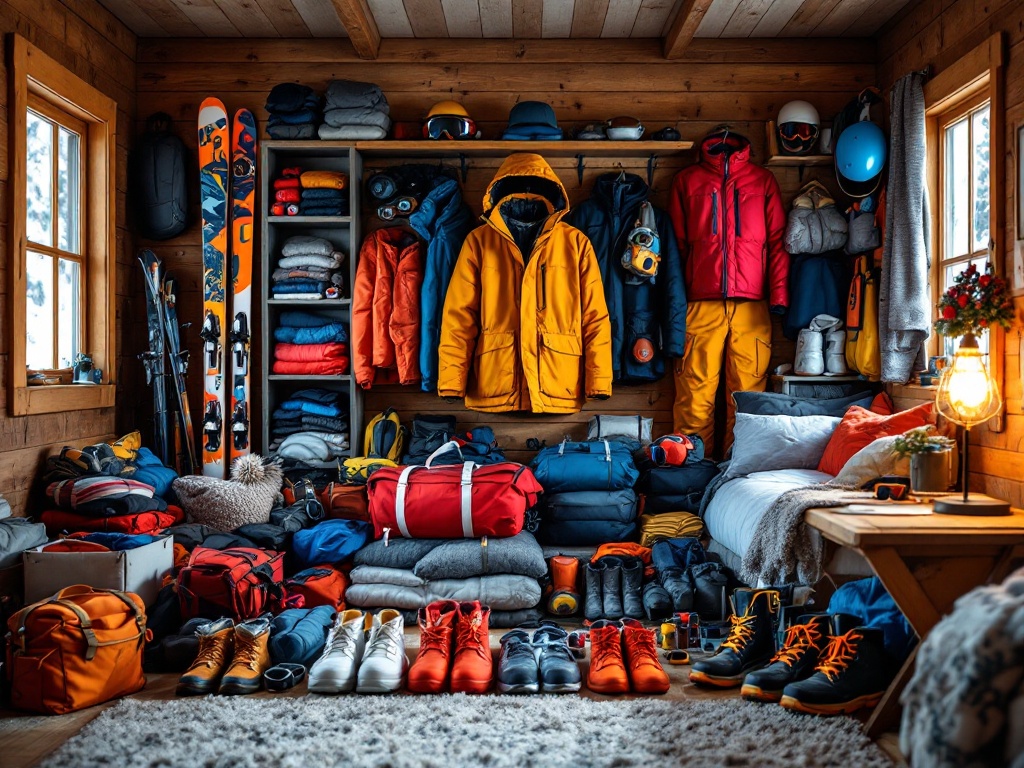What to Pack for a Ski Trip: Travel Essentials
Ready to conquer the slopes? This comprehensive guide ensures you’re perfectly equipped for your ski adventure. Learn how layering thermal underwear, fleece, and waterproof outerwear creates the ultimate defense against the cold. Discover essential gear like skis, poles, boots, and goggles, plus safety must-haves like helmets and avalanche beacons for off-piste exploration. Maximize your comfort and performance with expert packing tips and a printable checklist. Start planning your unforgettable ski trip now!
Important information

- Dress in layers: Start with thermal underwear as a base layer, add a fleece mid-layer, and finish with a waterproof and breathable outer shell (jacket and pants).
- Protect your extremities: Wear waterproof, insulated gloves or mittens, a hat, and a neck gaiter. Ski goggles are essential for eye protection and visibility.
- Essential gear includes skis, poles, boots, a helmet, and a backpack to carry water, snacks, and extra layers.
- Don’t forget sunscreen, lip balm with SPF, and moisturizer to protect your skin from the sun and cold.
- Travel insurance and necessary documents (passport, ID, medical information) are crucial for a safe and worry-free trip.
Ski Clothing Essentials
Start with thermal underwear as your base layer for essential warmth against the cold.
Add a waterproof ski jacket and insulated pants to stay dry on the slopes.
Layering is key: a moisture-wicking base layer, a fleece mid-layer for insulation, and a waterproof outer shell create a versatile system.
Protect your extremities with ski gloves or mittens for warm hands, and a hat and neck gaiter for added protection.
Wear ski goggles to shield your eyes from harmful UV rays and wind, improving visibility.
Layering Strategies for Warmth
Start with base layers that wick away sweat to keep you dry.
Add a mid-layer, such as fleece, for essential insulation.
Protect yourself with an outer layer that shields you from wind and rain.
Waterproof, insulated gloves or mittens are essential for warm hands.
Finish with moisture-wicking socks, which are crucial for comfort and preventing cold feet.
Thermal Underwear and Base Layers
Thermal underwear provides a vital base layer, trapping warm air against your skin to regulate body temperature and keep you warm. This layer also wicks away moisture for added comfort and dryness.
Mid Layers and Fleece Options
Mid-layers are essential for staying warm on the slopes. They trap your body heat, creating an insulating barrier against the cold, fleece jackets or sweaters are great examples. Fleece is a particularly good option because it’s lightweight, breathable, and quick-drying, providing excellent insulation without the bulk.
Outer Layers: Waterproof Jackets and Pants
Staying dry on the slopes is crucial for comfort and performance. A good set of waterproof ski apparel, including a jacket and pants, creates a barrier against snow, wind, and rain. Equally important is breathability; fabrics that wick away sweat will keep you dry and comfortable even during strenuous activity. Look for advanced materials like Gore-Tex. Layering appropriately beneath your outer shell further enhances warmth and comfort.
Waterproof and Insulated Clothing
Staying warm and dry is essential for hitting the slopes. Waterproof, insulated ski jackets and pants are your first line of defense against snow, wind, and freezing temperatures. Breathability is just as important. Choose materials that ventilate to prevent overheating and that clammy feeling. Consider pit zips for jackets and adjustable waistbands for pants. Comfort and performance go hand-in-hand. Stay comfortable, ski better.
Ski Gear and Equipment
Planning a ski trip? Here’s the essential gear you’ll need:
The Basics
- Skis, poles, and boots: these are the foundation of your ski setup. If renting, reserve the correct size and type in advance,
- Ski bag: vital for protecting your equipment during transport,
- Ski lock: handy for securing your gear during breaks.
On-Slope Essentials
- Backpack: indispensable for carrying snacks, water, and extra layers,
- Helmet: always a good idea for added protection.
Off-Piste Safety
Venturing off-piste? Prioritize safety with the following avalanche gear:
- Avalanche beacon,
- Probe,
- Shovel.
Essential Ski Gear: Skis, Poles, and Boots
Ready to hit the slopes? Don’t forget your essential ski gear: skis, poles, and boots.
Protective Accessories: Helmets and Goggles
Slope safety starts with having the right equipment. A helmet is essential to protect your head from falls. Goggles protect your eyes from snow, wind, and harmful UV rays, ensuring clear vision for safe navigation.
Ski Passes and Lift Tickets
Planning your mountain adventure? Secure your access to the slopes with a ski pass or lift ticket. Several options are available to suit your needs:
- Day passes: ideal for single-day trips.
- Multi-day passes: perfect for longer stays.
- Season passes: a great value for frequent skiers.
To save time and money, purchase your pass online in advance. Check the resort’s website for specific pricing, options, and potential discounts for families or groups. Be aware of dynamic pricing at some resorts, which means costs can fluctuate. Planning ahead helps ensure the best deal for your mountain adventure.
Accessories for the Slopes
Stay warm on the slopes with essential gear like gloves, mittens, and a neck warmer. Ski socks and insulated pants offer extra protection against the cold.
- Gloves, mittens, and a neck warmer,
- Ski socks and insulated pants.
Protect yourself from the elements with sunglasses and sunscreen. Pack a hydration pack and snacks for sustained energy.
- Sunglasses and sunscreen,
- Hydration pack and snacks.
Carry your ski pass easily with a ski pass holder. A multi-tool is handy for on-the-go adjustments.
- Ski pass holder,
- Multi-tool.
For extra warmth, bring hand and foot warmers. Keep everything organized in a backpack.
- Hand and foot warmers,
- Backpack.
Gloves, Mittens, and Neck Warmers
Stay cozy on the slopes by protecting your hands with gloves or mittens. Waterproof and insulated options offer the best defense against the cold. For added warmth, a neck warmer provides an extra layer of protection.
Ski Socks and Insulated Pants
Warm ski socks are essential for wicking away moisture, keeping your feet dry and comfortable for a more enjoyable skiing experience.
Insulated ski pants provide crucial warmth without restricting movement, allowing for flexibility and comfort on the slopes.
Sunglasses and Sunscreen
Protecting your eyes with sunglasses is essential. They shield your eyes from glare and damaging UV rays, which is especially important in bright, high-altitude snow where sunlight reflects with intensified power.
Sunscreen is also crucial. A high SPF helps prevent sunburn because snow reflects up to 80% of UV radiation, dramatically increasing the risk of sun damage. Protect your skin.
Hydration Packs and Snacks
Skiers should always carry hydration packs for convenient slope-side water access. Fueling up with smart snacks like granola bars, trail mix, or dried fruit provides sustained energy.
A reusable water bottle is also crucial for all-day hydration. Those with dietary restrictions should pack appropriate meals and snacks for their needs.
Off-slope and Après-ski Clothing
Pack the following items for your trip:
- Comfortable everyday essentials, such as sweaters, jeans, and sneakers.
- Dressier attire for dinners and social events.
- Swimsuit for relaxing in the hot tub or pool.
- Personal items like a captivating book or your favorite headphones.
- Sturdy winter boots for safe and comfortable walking in snowy or icy conditions.
Casual Clothing for Relaxation
After a day on the slopes, relax in comfortable après-ski attire, such as a cozy sweater and jeans. Pack comfortable shoes and a swimsuit for the hot tub or pool. Don’t forget personal items like a good book or headphones for some downtime.
Winter Boots and Snow Boots
Winter and snow boots are crucial for snowy escapades, providing essential warmth and grip. They keep your feet cozy and prevent slips and falls on icy terrain, ensuring both safety and comfort. Whether you’re strolling through a snow-dusted village or hiking a wintry trail, the right footwear is paramount.
Toiletries and Personal Care
Packing for a ski trip? Pack these essentials: travel-sized toiletries (shampoo, conditioner, soap, and other personal hygiene items), skin protection (sunscreen, SPF lip balm, and moisturizer), any necessary medications, contact lens solution (if needed), feminine hygiene products, and a small first-aid kit.
Toiletries
- Travel-sized shampoo,
- Conditioner,
- Soap,
- Other personal hygiene items.
Skin Protection
- Sunscreen,
- SPF lip balm,
- Moisturizer.
Health
- Necessary medications,
- Contact lens solution (if needed),
- Feminine hygiene products.
Safety
- Small first-aid kit.
Essential Toiletries for Ski Trips
Maintaining good personal hygiene is essential while traveling. Remember to pack your toothbrush, toothpaste, shampoo, conditioner, soap, and deodorant.
Protecting your skin from the elements is crucial. Include sunscreen, lip balm with SPF, and moisturizer. Don’t forget essential personal items like medications, contact lens solution, and feminine hygiene products. A compact first-aid kit can be invaluable for treating minor injuries.
SPF and Hydrating Products
Protecting your skin during winter, especially in snowy conditions, requires extra care. Apply sunscreen with an SPF of 30 or higher to shield against intensified sun reflection off the snow. Use a lip balm with SPF for added lip protection. Keep your skin hydrated by applying moisturizers and lotions to combat the drying effects of cold air and wind.
Additional Travel Essentials
Pack a durable travel bag for your clothes and gear. A ski backpack is also handy for slope essentials like water, snacks, and extra layers.
A well-stocked first-aid kit is essential. Include bandages, pain relievers, antiseptic wipes, and any personal medications. A whistle and flashlight are wise safety additions.
A portable charger will keep your phone and other devices powered up. A power adapter might be necessary depending on your destination.
Travel insurance is crucial, especially coverage for skiing activities. Carry copies of important documents like your passport, driver’s license, and medical information.
Travel Bag and Ski Backpack
Pack your clothes, toiletries, and personal items in a handy travel bag for easy organization. For ski trips, a backpack is key for carrying gear, snacks, and hydration. To keep everything protected and streamlined, consider separate bags for boots and equipment.
First Aid Kit and Safety Items
For minor injuries on the slopes, a well-stocked first aid kit is essential. Pack bandages, antiseptic wipes, pain relievers, and blister treatments.
A whistle is crucial for signaling help if needed.
For navigating in low light, bring a headlamp or flashlight.
A multi-tool can also prove useful for small repairs.
Mobile Phone Charger and Electronics
Essential Tech for Skiing
Stay connected on the slopes with a phone charger and a portable power bank for backup power. Capture your adventures with a camera or camcorder. Don’t forget international adapters if traveling abroad.
Tech for Downtime
Enjoy some relaxing downtime with an e-reader or tablet. Listen to your favorite music and podcasts with headphones or earbuds.
Travel Insurance and Documentation
Travel insurance is a safety net for your trip, covering cancellations, medical emergencies, and lost baggage.
Remember your essential documents: a valid passport or ID, driver’s license, and copies of your insurance policies.
For international trips, ensure you have any required visas and a printed itinerary with contact information.
Pack all necessary medications, including prescriptions.
Efficient Packing Tips
Use packing cubes to organize clothes and gear, compressing items to maximize luggage space.
Roll clothes instead of folding to prevent wrinkles and save space.
Place heavier items at the bottom of your suitcase and lighter ones on top for better balance.
Utilize empty spaces inside ski boots for small items like socks or gloves.
Pack a waterproof bag for wet clothes or toiletries.
Invest in sturdy luggage, but leave room for souvenirs.
Using Packing Cubes for Organization
Packing cubes are a game-changer for ski trips, compressing bulky items like jackets and pants to maximize luggage space. They also keep your ski gear separate from other clothes, maintaining order and allowing you to find things quickly without rummaging. Plus, they offer protection against spills and damage, ensuring a stress-free ski vacation. Using packing cubes offers several benefits:
- maximize luggage space by compressing bulky ski gear,
- keep ski gear separate for easy access,
- protect clothes from spills and damage.
Printable Ski Trip Packing Checklist
Get ready for your ski trip! Use this checklist to pack the essentials, from clothing and gear to important accessories.
Clothing
- Ski jacket,
- Ski pants,
- Base layers (thermal underwear),
- Fleece or sweater,
- Warm socks,
- Gloves or mittens,
- Hat or headband,
- Neck warmer or buff.
Gear
- Skis or snowboard,
- Boots,
- Poles,
- Helmet,
- Goggles,
- Ski bag or snowboard bag,
- Boot bag.
Accessories
- Sunscreen,
- Lip balm,
- Sunglasses,
- Backpack,
- Water bottle,
- Snacks,
- First-aid kit,
- Hand and foot warmers.
Other Essentials
- Travel documents (passport, visa),
- Insurance information,
- Medications,
- Cash and credit cards,
- Phone and charger,
- Camera and charger.
Planning specialized activities like ski touring or off-piste skiing? Remember to pack the specific equipment required for these exciting pursuits.









